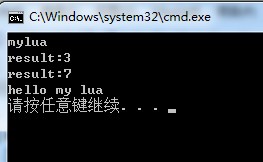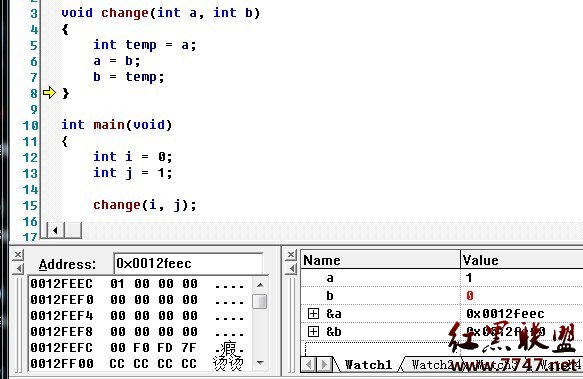C++ 的几种 cast 运算符到底是什么?与 C 风格的类型转换 (T)value 有什么区别和联系?
网上的文章但凡有提到 static_cast、const_cast、reinterpret_cast、dynamic_cast 的,都会语重心长的说,他们克服了 C 风格的类型转换的缺点,应当使用它们。可是,C 风格的到底有什么坏处?C++的这些 cast 又有什么好处呢?
昨天以前,我连这些 cast 是什么都不知道(很惭愧)。昨天因为同事们提到这件事,于是小小研究了一下。一些实验代码如下:
1、无继承的类型转换
class A
{
};
class B
{
public:
operator A()
{
return A();
}
};
int main()
{
B b;
A a = (A)b; // 执行 operator A()
A a2 = static_cast<A>(b); // 执行 operator A()
A a3 = dynamic_cast<A>(b); // 不允许
A a4 = reinterpret_cast<A>(b); // 不允许
A a5 = const_cast<A>(b); // 不允许
return 0;
}
2、const_cast
struct A
{
int m;
A(int m = 0) : m(m)
{
}
};
int main()
{
const A a;
A a2 = (A)a; // 允许,(A) 有没有都一样,a2 是个新变量
a2.m = 1; // a2 的改变不影响 a
A &a3 = (A &)a; // 允许
a3.m = 2; // 影响 a
// A &a4 = a; // 不允许,const 限定起作用了
A *pa5 = (A *)&a; // 允许www.zzzyk.com
pa5->m = 3; // 影响 a
// A *pa6 = &a; // 不允许,const 限定起作用了
// A aa2 = const_cast<A>(a); // 不允许
A &aa3 = const_cast<A &>(a); // 允许
aa3.m = 2; // 影响 a
A *paa5 = const_cast<A *>(&a); // 允许
paa5->m = 3; // 影响 a
const int i = 0;
const int &i2 = i;
const int *pi3 = &i;
// int j = const_cast<int>(i); // 不允许
int &j2 = const_cast<int &>(i2); // 允许
int *pj3 = const_cast<int *>(pi3); // 允许
return 0;
}
从第1点的试验,加上外界资料的说明,看上去const_case 只允许具有不同cv限定符的同类型之间的转换。
值得注意的是,如果类型A不是指针或引用,不能使用const_cast(使用了也无意义,见 A a2 = (A)a 这一行)
在 const_cast 可以使用的情形,(T)value 形式都可以使用,(T)value 在功能上完全覆盖 const_cast。
2、reinterpret_cast
class A
{
public:
operator int *()
{
return nullptr;
}
};
int main()
{
int i = 0;
double d = 1.0;
int *p = nullptr;
// int di = reinterpret_cast<int>(d); // 不允许
int pi = reinterpret_cast<int>(p); // 允许
// int pi2 = static_cast<int>(p); // 不允许
// double id = reinterpret_cast<double>(i);// 不允许
// double pd = reinterpret_cast<double>(p);// 不允许
int *ip = reinterpret_cast<int *>(i); // 允许
// int *ip2 = static_cast<int *>(i); // 不允许
// int *dp = reinterpret_cast<int *>(d); // 不允许
A a;
int *pa = (int *)a; // 允许
int *pa2 = static_cast<int *>(a); // 允许
// int *p2 = reinterpret_cast<int *>(a); // 不允许
return 0;
}
看上去,reinterpret_cast 可以理解为在指针和数值之间转换的一种方式,无关任何运算符重载,仅仅把指针转为字面值,或者把数字转为指针,转换的过程中值没有任何改变,只是告诉编译器不要报类型不匹配而已。
另外,在reinterpret_cast可以使用的情形,static_cast 是不可以使用的,除非定义了相应的类型转换运算符。
在 reinterpret_cast 可以使用的情形,(T)value 的方式同样可以完全胜任,(T)value 在功能上完全覆盖 reinterpret_cast。
dynamic_cast 我自认为还是理解的,就不试了。
综上,我的理解如下:
1、static_cast + const_cast + reinterpret_cast = (T)value
C++ 把原来C风格的的这三个cast拆分成了三个,三者相互正交。大多数情况下,应该是 static_cast 在取代着 (T)value;只是在去除 cv 限定符的时候,换用 const_cast;在取指针字面值的时候,换用 reinterpret_cast。类型转换运算符 operator T() 由 static_cast 负责执行。
2、dynamic_cast 是 C++ 新增的,用于多态的情形,且只允许转换具有多态关系的继承树上的类型的指针和引用,不允许转换类型本身。它不是针对 (T)value而出现的,两者没有任何竞争关系,只是取决于不同的需求。
(不知这样理解是否正确,请批评指正~)
至于网上推崇用新写法,是不是为了更细化而容易理解?有没有什么是 (T)value 做不到而 *_cast 能做到的?或者反过来?
摘自 溪流漫话
补充:软件开发 , C++ ,




